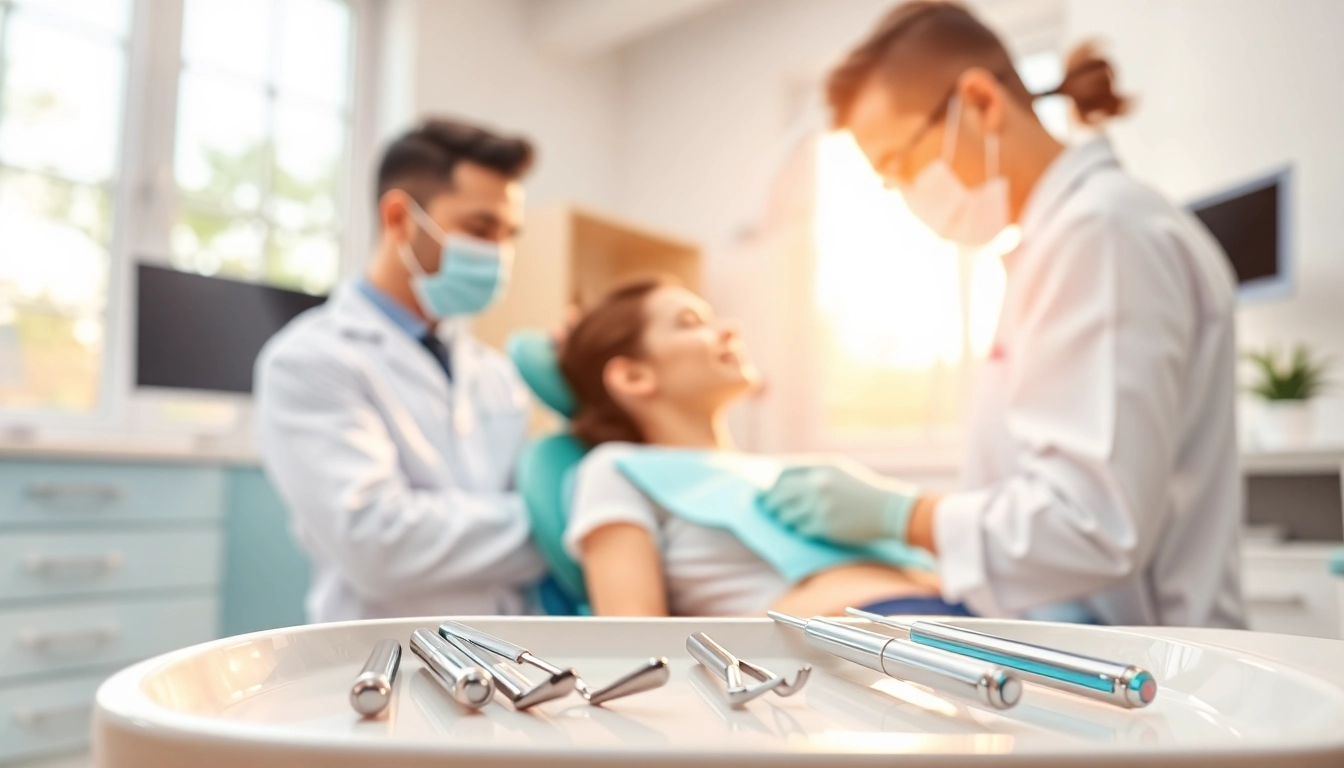What are Dental Cleanings?
Definition and Overview of Dental Cleanings
Dental cleanings, often performed by a dental hygienist, are essential non-surgical procedures aimed at maintaining optimal oral hygiene. During these cleanings, a professional dentist or dental hygienist removes bacteria, plaque, and tartar buildup from the teeth surfaces, ultimately preventing a variety of oral health issues. Dental cleanings are not just about removing visible debris; they also help detect early signs of gum disease and other dental problems that may require further intervention.
The Importance of Regular Dental Cleanings
Regular dental cleanings are vital for overall dental health. According to the American Dental Association (ADA), patients should schedule a professional cleaning at least twice a year. This routine helps to effectively mitigate the risk of tooth decay and gum disease, which can lead to more severe health consequences if left untreated. Regular cleanings not only keep your teeth looking bright and healthy but also contribute to a comprehensive oral care strategy. Dental cleanings serve as a preventive measure, allowing for early detection and management of potential oral issues.
Who Should Get Dental Cleanings?
Dental cleanings are recommended for everyone, regardless of age. Children can benefit from regular cleanings to establish good habits and manage the growth of their developing teeth. Adults, too, should prioritize cleanings to maintain their oral health. Individuals with specific conditions, such as diabetes or those who are pregnant, may need to schedule cleanings more frequently to help prevent complications. Consulting with a dental professional can help tailor a cleaning schedule based on individual needs and health considerations.
The Dental Cleaning Process
Step-by-Step Breakdown of Dental Cleanings
A standard dental cleaning involves several key steps:
- Initial Assessment: The dental hygienist begins with a thorough examination of your mouth, checking for any signs of gum disease, cavities, or other oral health issues.
- Removal of Plaque and Tartar: Using specialized instruments, the hygienist removes plaque and tartar buildup from the teeth and gum lines. Plaque buildup can lead to gum inflammation and decay, so this step is crucial.
- Gritty Toothpaste Cleaning: The hygienist uses a high-powered electric brush to clean the teeth with a gritty toothpaste that helps to polish teeth and remove stains.
- Expert Flossing: Flossing during a cleaning session is slightly different than daily flossing; the hygienist will take the time to ensure all debris is removed from between your teeth.
- Rinsing: After the thorough cleaning, you will rinse your mouth to eliminate any remaining debris and toothpaste.
- Fluoride Treatment: Finally, a fluoride treatment may be applied to help strengthen tooth enamel and protect against decay.
Tools Used in Dental Cleaning Procedures
Various dental tools and instruments are utilized during the cleaning process, each serving a specific purpose:
- Scaler: A hand-held tool used to remove plaque and tartar from the tooth surfaces.
- Ultrasonic scaler: This device uses high-frequency sound waves to break apart tartar deposits quickly.
- Polishing tools: These are electric brushes that clean and polish teeth, enhancing their brightness and smoothness.
- Floss: Traditional floss is used for cleaning between teeth, while specialized floss or tools may be used for braces or other dental appliances.
- Fluoride treatments: Gel or varnish may be applied to strengthen and protect enamel after the cleaning.
What to Expect During Your Appointment
When you arrive for your dental cleaning, you can expect a welcoming environment with a focus on your comfort. The hygienist will start with an assessment and may take X-rays to get a complete picture of your oral health. Understand that the cleaning process itself may cause minimal discomfort, but it should not be painful. You’ll be informed about what to expect at every step, and if you experience any discomfort, don’t hesitate to communicate this to the hygienist. The goal is to ensure a positive and thorough cleaning experience.
Types of Dental Cleanings
Basic vs. Deep Dental Cleanings
Dental cleanings can be categorized into two primary types: basic cleanings and deep cleanings.
- Basic Cleanings: Also known as prophylaxis, these cleanings are typically performed on patients with healthy gums and require minimal intervention. The hygienist removes plaque and tartar from the tooth surfaces above the gum line.
- Deep Cleanings: Also referred to as scaling and root planing, deep cleanings are necessary for patients with gum disease. This procedure extends below the gum line to remove tartar and bacteria from root surfaces, helping to restore gum health.
Special Considerations for Different Age Groups
As people age, their dental health needs evolve. For children, establishing a regular cleaning routine is crucial, as it helps in developing good oral hygiene habits early on. Teenagers may face challenges such as braces and other orthodontic treatments, requiring specialized attention. Adults generally focus on preventive care and monitoring issues like gingivitis, while seniors often have unique challenges related to tooth loss, sensitivity, and dry mouth. Each demographic benefits from tailored dental care strategies.
Choosing the Right Cleaning for Your Needs
Deciding between a basic and deep cleaning largely depends on your oral health status. Discussing your dental history and current issues with your dental professional can lead to a customized cleaning strategy. For example, if you have periodontal disease or are at risk for it, a deep cleaning may be necessary. Conversely, if your gums are healthy and you maintain good home care, a regular cleaning may suffice.
Benefits of Dental Cleanings
Prevention of Oral Diseases and Conditions
One of the primary benefits of regular dental cleanings is the prevention of oral diseases, such as cavities, gingivitis, and periodontitis. Removing plaque and tartar reduces the bacteria in your mouth, thereby lowering your risk of developing these conditions. Furthermore, early detection of potential problems allows for timely intervention and treatment, preventing costly or invasive procedures in the future.
Long-term Financial Benefits of Regular Dental Care
Investing in regular dental cleanings can lead to significant savings over time. Preventive care is generally less costly than restorative procedures resulting from neglected oral health. For instance, a small cavity can be treated easily during a routine cleaning, while periodontitis may require complex interventions, including surgery, which can become very expensive. Regular cleanings help you avoid these unnecessary costs, reinforcing the idea that they are an investment in your well-being.
Impact on Overall Health
The link between oral health and overall health is well-documented. Regular dental cleanings may lower the risk of systemic health issues, including heart disease and diabetes, which can be exacerbated by poor oral hygiene. The mouth is a gateway to the rest of the body, and maintaining its health is vital for overall well-being. Therefore, committing to regular dental cleanings not only improves oral health but also supports general health, enhancing quality of life.
Common Concerns and Questions about Dental Cleanings
Are Dental Cleanings Painful?
Dental cleanings are generally not painful. While some people may experience mild discomfort, particularly if they have sensitive gums or extensive tartar buildup, dental professionals use various methods to minimize discomfort during the procedure. If you’re anxious about pain, communicate this with your hygienist. They can take additional steps to make you more comfortable, such as using a topical numbing agent or adjusting their technique.
Frequency of Dental Cleanings Recommended
Most dental professionals recommend biannual cleanings for optimal oral health. However, depending on your individual needs and risk factors, your dentist may suggest more frequent visits. Some patients, particularly those with a history of gum disease or other risk factors, may require cleanings every three to four months to maintain their oral health. Adhering to your dentist’s recommendations will help you manage your oral hygiene effectively.
Addressing Myths and Misconceptions about Dental Cleanings
Many misconceptions surround dental cleanings, such as the belief that they are harmful or unnecessary. In reality, dental cleanings are a foundational component of maintaining oral health. Regular cleanings do not weaken the teeth; rather, they strengthen and protect them from disease. Another common myth is that cleanings are only for those with dental problems. In truth, people of all ages benefit significantly from routine cleanings regardless of their current dental status. Educating oneself about the realities of dental cleanings can empower individuals to prioritize their oral health effectively.



